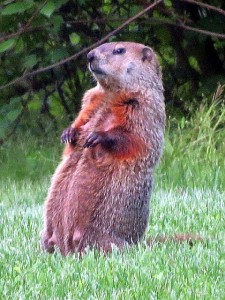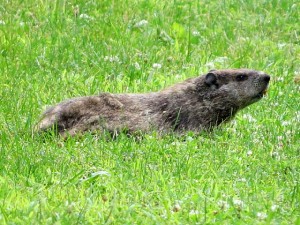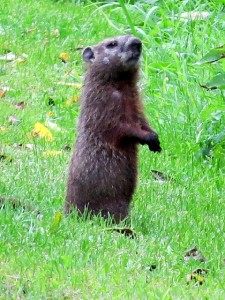Enjoy Winter! Groundhog
by Tim Burris, Mariton Preserve Manager. Photos by Carole Mebus.
As part of my series about how animals handle winter I thought I would start off the mammals with the Groundhog (Marmota monax). Groundhogs are also called Woodchucks, Whistle Pigs, and Marmots. A rodent, groundhogs are a member of the squirrel family. It is a good climber and I have seen them in trees often, especially eating mulberries and wild cherries. While they are good climbers, their legs, claws, head, eyes, and ears are best adapted for burrowing underground, and thus the name.
Most people think of open fields when they think of ground hogs, but they also den in wooded areas (thus the name Woodchuck). Some groundhogs build two dens: a summer den in a sunny field, and a winter den in a brushy or woody area. These dens are pretty extensive, with multiple tunnels and entrances, and different chambers for sleeping, hibernating and raising young. They even have a chamber for going to the bathroom.
Hibernation is how groundhogs deal with winter. Groundhogs are one of the few true hibernators in that they lower their body temperature, heart rate and respirations markedly during their winter sleep. Imagine if we lowered (and then maintained) our body temperature at 42 degrees Fahrenheit (the same amount that a groundhog lowers its body temperature)? Severe hypothermia sets in when our bodies drop to about 80 degrees. Besides the body temperature, the groundhog’s heart rate drops to about 4 beats per minute (!) and breathing slows considerably. Pretty amazing.
Of course, an important part of the groundhog’s hibernation strategy is a layer of stored fat to fuel the body during its period of inactivity. (This explains the “hog” and “pig” names.) Having lowered their metabolism so much they can get by on the stored calories. Groundhogs like other herbivores have the ability to convert complex carbohydrates into protein and fats. (Grasses, clover, and goldenrods pass right through our digestive systems without leaving any calories for our bodies to use.)
Before hibernating, groundhogs seal the entrances to their burrow with dirt which maintains the temperature at a balmy 50+ degrees. Then they curl up into a ball in their leaf lined hibernation chamber. Many people don’t realize that groundhogs rouse periodically during their slumber (some call it a deep coma) to walk around their burrow and go to the bathroom (explaining the bathroom chamber). This periodic activity probably prevents damage to the brain, organs, muscles and bones that one would expect after such a long period of inactivity.
So when Maureen asks me what I plan to do on a winter weekend; I am joking when I tell her that I plan to “hibernate” with a good book by the woodstove. (You can decide which part of that statement is the joke.)
Sources: Joseph F. Merritt’s Guide to the Mammals of Pensylvania, Audubon Field Guide to Mammals.



